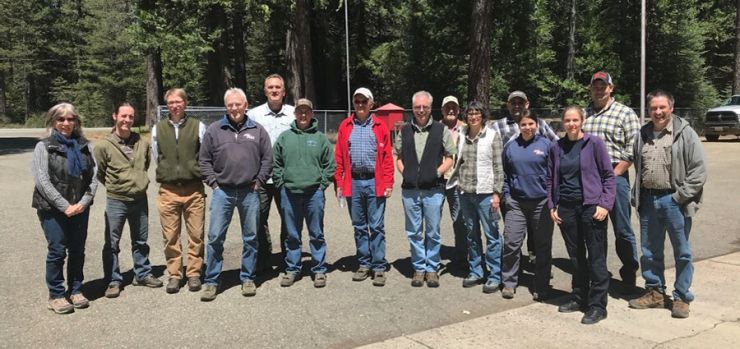CLFA - CAL FIRE Archaeologist in Woods Show
Posted at 12:45 PM on May 7, 2018
Article written by Clayton Code
On May, 2, 2018 some CLFA Board members met with all of the CAL FIRE State Archaeologists as a follow up discussion from the January CLFA-CAL FIRE Archaeology meeting held in Williams. The meeting took place in Shingletown, CA and some special thanks goes out to Station #22 of the Shasta-Trinity Unit for hosting our meeting. Items that were discussed included Enforceable Language in Confidential Archaeological Addendums (CAA), Ex-amples of successful implementation and monitoring of Protection Measures, Sharing Archaeology Information Dig-itally with Information Centers, and a Discussion on Definition of Significance. The meeting was followed up with a Logging Demonstration involving a mock archaeology site. Creekside Logging, in conjunction with the Sierra Cascade Logging Conference, provided timber fallers and logging equipment for the demonstration. A special thanks to members Clayton Code, Ted James, and Delbert Gannon for arranging the logging demonstrations.
Highlights from the meeting included the following: Discussion on impacts, and significance of those impacts, when proposing to operate within or adjacent to a site. Emphasis was added that stress that Protection measures must be written such they are enforceable within the CAA itself, and be written such that the LTO can understand and feasi-bly implement the protection measures. Also talked about was changing environmental conditions (fire, flood, vege-tation, ground visibility) that may change or alter previously submitted site boundaries. A possibly new trend many of us will encounter is questions regarding accuracy of site boundaries. Small changes in site conditions as they relate to ground visibility can have dramatic effects on previously identified site boundaries. Expect more questions related to site boundaries because operations adjacent to an incorrectly delineated site has the potential to cause a significant effect to the site. Consider including a description of the on-the-ground steps taken to verify site boundaries have or had been correctly identified up front in the CAA. A previous survey that does not adequately describe ground visibility and/or does not adequately describe survey methodology will likely carry little weight when trying to leverage against it as a means to not duplicate previous work.
Pre-consulting and targeted PHIs are universally favored by CAL FIRE archaeologists, though they are aware that interest and availability will not be equal across landowner types. Sometimes previous surveys and logging impacts are introduced as factor to consider, if doing so be sure that previous surveys have enough information to evaluate the adequacy of survey coverage and ground visibility at that time compared to current conditions. When it comes to previous logging disturbance, depending on the nature of the site and local geology, there may be pristine subsurface elements of the site below that disturbance and questions may arise as to whether proposed disturbance may progress deeper into the soil profile compromising those undisturbed deeper elements.
We were reminded that the CAA has to stand on its own and reliance on BMPs or operational restrictions that only appear in Section II of the THP is problematic and has to provide adequate information to validate that the RPF and CAL FIRE archaeologists have performed their respective due diligence in surveying and protecting sites as appro-priate. Continued success of our program and the people involved are dependent on non-timber program agencies’ ability to evaluate that sites are appropriately protected and CAL FIRE archaeologists’ oversight is adequate. There is a possibility that there may be an increase in requests to monitor logging activities near archaeological sites in ex-ceptional circumstances. Board Member, Tony Gomez, provided an excellent example of a Post Operations Moni-toring Report for a very complex Logging Camp located in Humboldt County where he successfully harvested trees within the site without any significant impacts to the site. Information Centers are making great progress in digitizing site records and surveys, with the goal of transitioning to electronic exchanges of information. This will result in accurate site records, whose image quality will not degrade with time.
RPF determination of site significance has been a hot button topic for years. The unfortunate reality is, to truly make a determination of significance is almost always more time consuming and costly than the trees in question are worth. CAL FIRE Archaeologists favor using a starting point of all sites being significant with default protections of flag-and-avoid. By shelving the question of site significance, the conversation is reduced to whether operations will have a significant effect on the site. Flag-and-avoid will almost always assure no significant effect, where operations are proposed within a site, evaluation of significant effect on the site can be addressed one-on-one with your local CAL FIRE archaeologist ideally through pre-consultation, or focused PHI.
The logging demonstration in the field consisted of directional tree falling adjacent to and within a mock site area. Falling was done by hand, and with a John Deere Feller Buncher. The falling operations were followed by skidding and yarding with a dozer. Overall, the discussion and demonstrations were positive and triggered a question and answer session on the feasible and possible ways to perform timber harvest operations adjacent to and within arch site areas. Key items that were taken away from the demonstration were potential for ground disturbance exists only where, moving trees, and falling trees make contact with the ground. Additionally, we demonstrated that logging equipment can operate in a site with no mineral soil disturbance.
Clayton Code

Left to Right: Amy Huberland, Ben Harris, Steve Grantham, Gerrit Fenenga, Mike McGuirt, Clayton Code, Richard Jenkins, Herb Dallas, Mike Bacca, Stephanie Vasquez, Tony Gomez, Stephanie Duncan, Denise Rizzica, Alex Stone, Kieran O’Leary.
